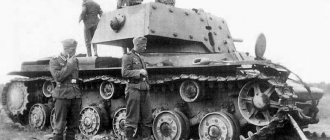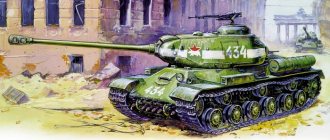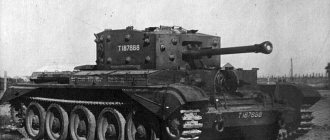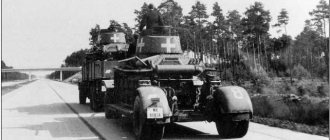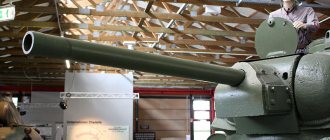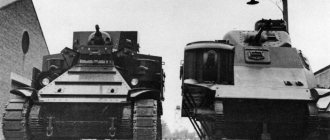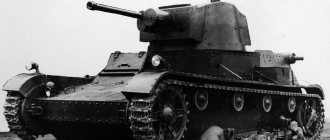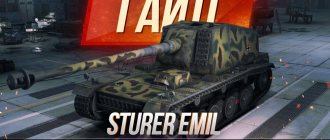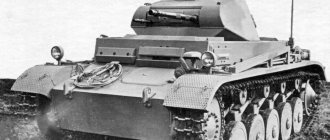Home » Unimplemented projects of tanks and other armored vehicles of the USSR » Yuri Pasholok. Project of a light self-propelled gun with an 85 mm cannon or Su-85 late to the war
Unrealized projects of tanks and other armored vehicles of the USSR
boroda 01/14/2019 3203
18
in Favoritesin Favoritesfrom Favorites 11
The SU-76M self-propelled gun , which became the second most popular combat vehicle of the Red Army during the war, was armed with a 76-mm ZIS-3 divisional gun. This system was one of the best created by V.G. Grabin, and had good characteristics. At the same time, attempts to install more powerful guns on a self-propelled gun have been made repeatedly, and some options, for example, SU-85B
, were even close to launching into series.
Nevertheless, the Red Army never received a domestic analogue Marder self-propelled gun .
Modules:
Turrets/guns
| Lv. | Tower | Armor (mm) | Rotation (deg/sec) | Review (m) | Weight, kg) | Price (credits) |
| IV | SU-85 | 0/0/0 | 44 | 280 | 100 | 100 |
Compatible weapons:
| Lv. | gun | Penetration (mm) | Damage (HP) | Rapid fire (rounds/min) | Spread (m/100m) | Mixing (c) | BC | Weight, kg) | Price (credits) |
| V | 76 mm S-54S | 125/156/39 | 115/110/165 | 14.63 | 0.39 | 2.3 | 52 | 1 390 | 39 470 |
| V | 122 mm M-30S | 61/140 | 450/370 | 5.26 | 0.55 | 2.3 | 32 | 1 600 | 42 500 |
| VI | 85 mm D-5S | 120/161/43 | 160/160/280 | 13.33 | 0.43 | 2.3 | 48 | 1 500 | 61 530 |
| VII | 85 mm D-5S-85BM | 144/194/44 | 180/180/300 | 10 | 0.34 | 2.3 | 38 | 1 850 | 73 600 |
Engines
| Lv. | Engine | Power (hp) | Fire probability (%) | Weight, kg) | Price (credits) |
| V | AT 2 | 480 | 15 | 750 | 18 750 |
| VI | V-2-34 | 500 | 15 | 750 | 27 860 |
Chassis
| Lv. | Chassis | Max. load (t) | Turning speed (gr/sec) | Rmin | Weight, kg) | Price (credits) |
| IV | SU-85-II | 31.4 | 33 | 0 | 7 600 | 3 800 |
| V | SU-85 | 32.4 | 35 | 0 | 7 600 | 8 640 |
Radio stations
| Lv. | Radio station | Communication range (m) | Weight, kg) | Price (credits) |
| IV | 9Р | 325 | 80 | 1 980 |
| VIII | 9RM | 525 | 100 | 24 240 |
Visibility
Visibility is the main trump card of the SU-85. World of Tanks (more precisely, its developers) in this regard did not sin at all against realism. This model of self-propelled gun has an excellent stereo scope, which allows you to shoot enemies from an extremely long distance, while remaining unnoticed. Another “trick” is the extreme mobility of this self-propelled gun.
This is due to the small mass of this equipment: equipped with a fairly powerful engine, it can accelerate to very decent speeds (for those times, of course). If you “steer” your equipment competently and quickly, then you can manage to beat your enemies on two fronts at once.
And this is precisely what is good about the SU-85. “World of Tanks” does not include many vehicles of this class, so this should be used to the fullest.
The main danger is a direct (or even tangential) hit from a high-explosive fragmentation projectile or a ram. We will not even mention the danger of using armor-piercing shells against you, since this is quite obvious. Thin armor and the actual lack of closure of the wheelhouse are your certain death in this case. Don't forget that a more or less serious tank will easily throw you off any cliff.
Order of studying modules:
| Chassis | gun | gun | Engine | Radio station | gun | |
| Result: Experience: 34,965 Loans: 238,370 | ||||||
| SU-85 | 85 mm D-5S | 85 mm D-5S-85BM | V-2-34 | 9RM | 122 mm M-30S | |
| 2105 experience - 8640 credits | 4600 experience - 61530 credits | 15500 experience - 73600 credits | 5000 experience - 27860 credits | 4040 experience - 24240 credits | 3720 experience - 42500 credits |
More details on the research.
- Suspension SU-85 - will add carrying capacity and also increase the maneuverability of the tank.
- 85 mm D-5S gun - increases combat effectiveness and opens access to the 85 mm D-5S-85BM.
- The 85 mm D-5S-85BM gun has normal penetration and good accuracy.
- Engine V-2-34 - significantly increases dynamics.
- Radio station 9РМ - increases communication range.
- 122 mm M-30S gun - required to be researched to obtain Elite status.
Important Notes
Note that among the equipment produced in the USSR there are a lot of machines whose characteristics are largely similar to each other. The aforementioned 85 model and the SU-100 are almost identical self-propelled guns.
Both of them are practically no different from the legendary SU-76. In fact, in reality everything was exactly the same: these self-propelled guns belong to the same family, being equipment of the same line. Thus, if your account level already allows you to use the SU-85B, you are well prepared even for very serious battles.
Crew:
- Crew commander (radio operator);
- Gunner;
- Driver mechanic;
- Charging.
Learning additional skills for the crew:
Standard crew
:
| 1 | 2 | 3 | 4 |
For the first slot, we teach all crew members the “ Camouflage” , and for the commander the “ Sixth Sense” skill - the “Camouflage” skill will reduce the overall visibility of the tank, and the “Sixth Sense” will allow you to determine whether his tank is detected by the enemy. Also, all crew members need to learn an additional skill “ Combat Brotherhood” , which improves the level of proficiency in the specialty, must be studied by everyone at once, preferably used in the second or third slot.
- the Eagle Eye skill , which increases the viewing range.
- For the gunner we learn the skill “ Smooth turret rotation” , which reduces the spread when turning the turret; and the Sniper , which increases the chances of causing damage to modules and crew members.
- For the driver mechanic, we learn the “ Smooth Move” , which reduces the dispersion of the gun in motion; and the Off-Road King , which reduces drag on soft to medium ground when driving.
- For the loader, we learn the skill “Non-contact ammo rack ,” which increases the strength of the ammo rack; and the skill “Desperate” , which reduces the reload time when less than 10% strength remains.
Game Tips
Since our gun’s accuracy is not very high, and the aiming process takes a very long time. The traditional model of playing tank destroyers does not suit us. We must be as close to our opponents as possible, but at a safe distance. That is, we must calmly target the enemy’s vulnerable areas, but also not expose ourselves to return fire. Various fortifications, barriers and terrain folds can help us with this. If you find yourself in a battle with opponents above your level, then it is better to stay as far away as possible. Because the thickness of the armor cannot protect us from shots from tanks above level 5.
Equipment, gear and ammunition:
List of equipment that can be installed on the SU-85:
Equipment for the SU-85 tank:
Support tactics, you need to install the Rammer, Reinforced Aiming Drives, and Improved Ventilation . On the first slot we install complex Rammer equipment, which increases the reload speed by 10% . On the second slot we install complex equipment: Reinforced aiming drives, which increases the gun aiming speed by 10% . In the last slot we install complex equipment Improved ventilation, which increases the level of proficiency in the main specialty and additional skills by 5% .
For the Ambush-Sniper Rammer , Stereo Tube and Camouflage Net equipment . On the first slot we install complex Rammer equipment, which increases the reload speed by 10% . On the second slot we install the removable Stereo Tube equipment, which adds + 25% of a stationary vehicle after three seconds after stopping. On the last slot we install removable equipment Camouflage Network, which significantly reduces the visibility of a stationary vehicle three seconds after stopping.
Equipment:
List of equipment that can be installed on the SU-85:
The equipment should be equipped with a standard set of equipment: Small repair kit , Small first aid kit , Hand fire extinguisher . The fire extinguisher can be replaced with Lend-Lease oil , which will increase engine power by 5% . For tournaments or when there are a lot of credits, you can replace the fire extinguisher with Extra Ration 10% to all skills .
Ammunition:
85 mm D-5S-85BM gun - we’ll take most of the armor-piercing shells, but against more armored opponents it’s worth taking a few premium sub-caliber shells, which will make the game easier. High-explosive fragmentation shells will be useful for us to shoot down the capture of the base and finish off opponents with a small margin of safety. The total ammunition load is 38 shells.
Assembly of equipment, consumables and ammunition - Support:
| 26 | 10 | 2 | ||||||
Assembling equipment, consumables and ammunition - Ambush Sniper:
| 26 | 10 | 2 | ||||||
Transition to medium caliber
Even in the summer of 1943, it became clear that the armor penetration of the ZIS-2 was insufficient to combat the new German tanks. Under the leadership of N.A. Astrov at GAZ named after. Molotov at the end of 1943, the SU-85 GAZ self-propelled unit was developed and built, which also had the factory index GAZ-75. This vehicle was a development of the GAZ-74 self-propelled guns, differing from it not only in a more powerful weapon, but also in enhanced armor protection. With a combat weight of 14.5 tons, the thickness of its upper frontal plate was 82 mm. The tests, which took place from January 3 to March 8, 1944, were generally successful, but the vehicle was not modified.
The reason for this was the “torpedoing” of A.A. Liphart, the brainchild of Astrov. Since the end of 1943, the chief designer began a quiet (and in some places not at all quiet) war against military production at GAZ. No, Andrei Aleksandrovich was not a saboteur: he was driven by the need to reorient the plant to the production of “peaceful” products. In addition, since the GAZ-75 self-propelled gun was in many ways a new vehicle, its production required a major restructuring of the plant’s capacities. Since the production volume of self-propelled guns needed to be increased, the introduction of the GAZ-75 into the series turned out to be impossible.
A special stand on which the operation of the chassis was tested with an increase in weight to 12 tons
With the death of the GAZ-75, attempts to strengthen the armament of light self-propelled guns did not stop. In May 1944, the factory design bureau, instead of creating a fundamentally new vehicle, decided to develop it on the basis of the SU-76M. Work in this direction became possible thanks to the position of military acceptance, primarily engineer-colonel Okunev. The new development received the index SU-15A. The absence of the GAZ designation in the index was explained simply: the base of the vehicle was the SU-15M, developed by the design bureau of plant No. 38.
Astrov headed the work on the SU-15A, and I.V. became the leading engineer of the vehicle. Gavalov. During his long design career, Igor Valentinovich often had to solve complex technical tasks, and this development was no exception: a gun that was originally created for heavy and medium tanks had to be built into a light chassis.
This document is one of the few evidence of work on installing the 122-mm M-30 howitzer on the SU-76M. It didn't even get to the preliminary design stage
In May 1944, several versions of the vehicle were developed. We chose the simplest one: the 85-mm D-5S-85 system was installed on the existing SU-15M hull. The system's armor was similar to that received by the GAZ-75. The rear part of the vehicle was changed, in particular, the lower rear sheet was made vertical so that the increased stowage of cartridges for the D-5S-85 could fit inside. Since the combat weight, according to calculations, grew to 12 tons, it was necessary to strengthen the chassis. The rear and front balancers of the road wheels were received as additional elastic spring elements. Instead of support rollers, runners (slides) were installed.
SU-85A in the factory yard, August 1944
In order to verify the possibility of installing the D-5S-85 on a light chassis, in May 1944 the conventional SU-76M was armed with this system. Firing tests gave satisfactory results. The vehicle was shown to Marshal of the Armored Forces Fedorenko, who approved the development.
At the end of May 1944, the head of the GBTU KA, Lieutenant General Vershinin, contacted GAZ named after. Molotov and to plant No. 9 with a request to develop another self-propelled gun. It was proposed to install a 122-mm M-30 howitzer on the SU-76M base. Instead of GAZ, plant No. 38 took up the work, having been working on this topic since April 1944. Alas, in July 1944, work was curtailed due to the decision to transfer plant No. 38 from Kirov to Kharkov to the site of plant No. 75. The preliminary design of the vehicle was not even completed (unlike the OSU-76 and ZSU-37 projects, which were transferred to plant No. 40). The Soviet light howitzer self-propelled gun died without really being born.
But the SU-15A was not only built, but also had a very stormy fate. However, this car could also “disappear” even before construction. In June 1944, the GBTU KA proposed in a letter to stop work on the “SU-85 based on the SU-76”, since the SU-76M met all the requirements that were placed on it.
The large D-5S-85A system was able to fit into a fairly small base
In June-July, the fate of the vehicle, which at that time began to be designated as SU-85A, hung in the balance. There was a very hectic correspondence between the GBTU KA, the People's Commissariat for Medium Engineering (NKSM) and the State Autonomous Institution KA. The fate of the SU-85A was determined at the end of July 1944, when the chairman of the Arktom GAU, Lieutenant General Khokhlov, in a letter called the topic of this self-propelled gun urgent. GBTU KA surrendered: on August 2, an order was signed by the NKSM and GBTU KA to conduct factory tests of the vehicle.
By that time, the prototype SU-85A was already ready. Its combat weight slightly exceeded the calculated one and amounted to 12.2 tons. Instead of the D-5S-85, the vehicle received a different system - the D-5S-85A from plant No. 8. Due to the fact that the dimensions of the 85 mm cartridges were larger, the ammunition load was reduced to 42 pieces. True, everything turned out to be relative: on the larger SU-85, the ammunition load turned out to be not much more - 48 rounds of ammunition for the D-5S-85A. The SU-85A was equipped with a breakable telescopic sight TSh-15, which was more convenient for the gunner to use. The track of the prototype was widened by 40 mm, and it received more durable torsion bars.
Initially, the commander's viewing device was sealed in the front panel of the cabin. It can be seen that the gun is installed offset to the left
During factory tests, the car covered 612 kilometers, including 360 with a standard engine and 252 with a forced engine. The self-propelled guns needed a new power plant due to the fact that the combat weight increased by more than 1.5 tons. The average speed on a cobblestone highway with the first power plant was 30 km/h, and on a dry country road - 20.8 km/h. With a forced engine, the average speed on the highway did not change, but on the country road it increased to 21.3 km/h. Installing springs to strengthen the suspension turned out to be the right decision, especially when driving at maximum speed. For example, where the SU-85A was traveling at a speed of 30 km/h, the SU-76M could not move faster than 20–22 km/h.
At first, the car suffered from various childhood diseases. I had to replace some elements of the chassis. However, the replacements were made to increase the reliability of the machine, and not because of defective parts. The exception was the failure of the tire of one of the right road wheels (vulcanization defect) and the separation of the rivets of the right front track bumper.
Rear view of the self-propelled gun with the awning raised
The next stage was field testing, which took place from September 8 to September 20, 1944. It was planned that the car would cover 1000 kilometers, but in practice this distance increased by one and a half times. The fact is that at the 570th kilometer, due to poor-quality heat treatment, the right final drive mechanism failed. After repairs, sea trials began again, as a result of which the total driving distance increased to 1,570 kilometers. 690 kilometers of the journey were on the highway, and another 880 kilometers the car traveled along a country road.
Instead of a forced engine, the SU-85A was equipped with a regular GAZ-203. The maximum speed was 44.3 km/h. When driving on a highway, the average speed was 32.1 km/h, and on a country road - 18.4 km/h, which approximately corresponded to the performance of the SU-76M. Fuel consumption also remained within the normal range: 97 liters per 100 kilometers on the highway and 169 liters when driving on a country road. In terms of cross-country ability, the vehicle was also quite comparable to the SU-76M.
Fighting compartment of the SU-85A
Things were worse with the fighting compartment. The layout of the commander's workplace was not the most successful. The viewing device was moved forward and upward, which made observation to the left and right difficult, and it was completely impossible to look back with its help. The viewing gap in the front deckhouse was sealed, which also worsened visibility. The gunner's workplace was rated as comfortable, but due to the new system of gun mounts, the gunner began to interfere with the loader. The front (main) stowage was located in front of the gunner, and the loader could only reach it with his help.
It also turned out that the weapon system was unbalanced. During sea trials, the dust raised by the vehicle flew inside the vehicle, making the crew’s work impossible, and clogged the inspection instruments. The system for removing the gun from the stop while traveling without leaving the vehicle worked poorly.
During sea trials, the SU-85A showed characteristics at the level of the SU-76M
Nevertheless, the commission considered that the SU-85 had passed the tests and recommended that the vehicle be adopted by the Red Army. At the same time, it was necessary to make alterations to the design of the artillery system and the fighting compartment in order to eliminate the identified deficiencies.
The Artillery Committee of the GAU KA turned out to have a completely different opinion. The conclusion dated October 31, 1944 stated that the SU-85A did not pass the test. It was noted that the vehicle, designated SU-85-GAZ, has a lot of shortcomings both in the fighting compartment and in the D-5S-85A system. A significant part of the complaints were fair, since there were significant problems when shooting, especially at moving targets. When firing, the car was not stable enough. The weapon was also problematic because it had excessive resistance to recoil.
From the point of view of driving performance, the SU-85A turned out to be quite successful. The vehicle's gun and fighting compartment failed
In its verdict, Artcom GAU KA proposed to continue work on the self-propelled guns, while simultaneously starting work on a new system, more suitable for a vehicle of such a small mass. In response to this, on November 5, 1944, Astrov criticized the conclusion. According to Astrov, a significant part of the problems lay not in the self-propelled gun chassis, but in the artillery system. Some of the conclusions from the report are Deputy Chief Designer of GAZ named after. Molotov called them completely ridiculous. For example, the “ineffective” firing of the SU-85A on the move turned out to be more effective than that of the SU-76M. The conclusions about low accuracy when firing at the maximum rate of fire also looked strange. After all, depending on the nature of the tests, you can get either a maximum rate of fire or accuracy from a gun. In his letter, Astrov demanded to reconsider the conclusion, which had a lot of outright inaccuracies. He brought with him “heavy artillery” in the form of the leadership of the USA GBTU KA, which also turned out to be on the side of the SU-85A.
SU-85A after modifications at the NIBT Test Site in January 1945
The struggle between the two departments did not change the fact that the car required improvement. In addition, the D-5S-85A system, which was installed on the prototype, was discontinued in December 1944 along with the SU-85M. Therefore, it was decided to build the second sample of the SU-85A taking into account the identified shortcomings and with the 85-mm ZIS-S-53 gun.
Meanwhile, work on the first prototype continued. By the end of 1944, the car had covered 2,635 kilometers. 844 shots were fired from the gun, 473 of them with reinforced charges. The system has been redesigned and better balanced. A number of changes were made to the chassis design. The cabin received completely closed sides and stern. A large hatch appeared at the back, although getting out through it was not particularly convenient. The alteration of the wheelhouse did not increase the protection of the gun crew, but significantly improved the situation with dust getting into the crew compartment. Also, a commander's viewing device appeared in the frontal area, and the gunner's viewing devices were also changed. After modifications, the combat weight increased to 12.3 tons.
The chassis has also been redesigned. The crown of the drive wheel now had 13 teeth instead of 15, the track bumpers were changed, and the left final drive with an increased critical speed received a tubular axle shaft. The stern plate of the hull in the place where the towing hook is welded has been strengthened. Also on the body there is a mount for a self-pulling log.
The viewing device in the front hull was returned to the commander
The converted SU-85A was sent to the NIBT Test Site in Kubinka, where the vehicle was tested from January 6 to January 19, 1945. There she walked 1028 kilometers (511 on the highway, 330 on the country road and 187 on virgin soil). And in winter conditions the car behaved at the level of a regular SU-76M. An increase in weight by two tons did not affect the reliability of the vehicle; no breakdowns were noted during testing. Average speeds of 29.2 km/h on the highway, 22.1 km/h on a country road and 17.1 km/h on virgin soil, shown in winter conditions, also corresponded to the driving characteristics of the lighter SU-76M. The maximum angle the vehicle could overcome was 25 degrees; beyond that, it lacked the grip of the tracks on the snow-covered ground.
The rear part of the vehicle has undergone the most significant changes.
A completely different picture was observed during fire tests. The comments of the GAU Artcom regarding the D-5S-85A gun were justified. This system was well suited for the SU-85, KV-85 and IS-85, but was not particularly suitable for a light self-propelled gun. High recoil resistance was not easy to eliminate, so the results of fire tests were predictable. While the SU-76M and SU-85 practically did not drift in the longitudinal plane when firing, the SU-85A had a non-reversible retreat value of 380–457 mm with the tracks released. The amplitude of vertical oscillations turned out to be significant. When fired, the car turned slightly to the left. Accuracy turned out to be satisfactory, and the targeted rate of fire was six rounds per minute, that is, at the level of the SU-85.
It turned out that shooting at moving targets at a distance of 1.5 kilometers, although possible, is not effective due to difficulties encountered by the vehicle commander when adjusting the fire. There were also problems with the strength of the system: the Belleville springs turned out to be deformed after a run of 200–300 kilometers. Because of this, the load on the aiming flywheels increased to 12–15 kilograms. The problem with backlash in the guidance mechanisms also persists. When firing at the protection of the mobile armor from the MG 42 machine gun, spray from bullets fell into the fighting compartment.
The fighting compartment of the modified vehicle
The conclusion of the NIBT Polygon turned out to be close to the previous report. The SU-85A chassis was quite reliable, but the gun clearly required replacement. A significant alteration of the vehicle, and especially its artillery unit, became inevitable.
More detailed information about the technique:
The SU-85 battle tank is significantly different from its predecessor visually and in terms of characteristics. The 85 mm D-5S-85BM gun has high single-shot damage, normal penetration and good accuracy, but takes a long time to aim. The armor of the frontal part is only 45 mm, which is very small, but there is a slope, which sometimes allows you to get a ricochet. A low safety margin allows the enemy to destroy a combat vehicle with one shot, which is the most important drawback. Based on the above, it is better to use AT at medium and long distances to increase the chance of survival. Excellent running characteristics allow you to quickly move around the map, and also, in case of danger, change the flank or return to base.
In summary: The SU-85 tank is said to be great for earning credits, but in fact it’s even difficult to fight with it against your own level, let alone the seventh. However, the next combat technique in the branch already allows you to fight excellently.
SU-85I armor scheme
In the forehead, the tank has 50 mm of armor at the bottom of the hull and 60 mm at the top. The tank has good armor for its level. The huge commander's cupola has 30 mm of armor.
The lower part of the stern is equally well armored and has 50 mm of armor. The upper part of the hull is poorly armored and has 25 mm of armor. The sides are also poorly protected. Their armor does not exceed 30 mm.
History of changes:
Update 0.6.7
- The horizontal traverse speed of the gun has been reduced by 6 degrees/sec.
Update 0.7.5
- The 107mm ZiS-6S gun has been removed. Instead, an 85mm D-5S-85BM gun was added. All accounts where the 107mm ZIS-6S gun was studied were awarded 14,400 free experience as compensation. All 107mm ZIS-6S guns were sold from warehouses - funds were credited in silver to account accounts.
- The 107mm UBR-420 P shell for the 107mm ZiS-6 gun has been removed. All 107mm UBR-420P shells have been removed from the warehouse, and gold has been credited to the account instead.
Update 0.8.6
- Profitability increased by 10%.
Update 0.9.8
- The tank has been redesigned with a new visual quality.
Battle tactics
How to play the SU-85 in order to knock out as many of your enemies as possible without exposing yourself? It's simple. You should sit in the bushes, aim well and knock out the enemy in the sides and stern. It can be assumed that first of all you need to knock out the most dangerous opponents. Since the depth of penetration allows, one can even hope for a frontal attack.
As you can see, we didn’t tell you anything special. Be sure to take advantage of the maneuverability of this anti-tank weapon, since in other cases only it will provide any opportunity to destroy enemy heavy tanks.
Camouflage and visibility
As a rule, camouflage allows you to relatively confidently destroy enemy equipment from 320 meters. But it’s better to keep a low profile and try to use the camouflage net to its fullest. Let enemy vehicles come to the minimum possible distance. If you use a high-quality weapon, you will have every chance of destroying the enemy before he can target your car.
The visibility of this self-propelled gun is one of its most optimal parameters. Therefore, you should not get out ahead of everyone, trying to get to the front of the battle. Considering the visibility of the vehicle, they will probably destroy you much faster than you can take aim. If you don't have enough visibility, use a stereo tube. Their importance is very high in the case when your allies cannot provide normal rear coverage.
Here is a review of the SU-85. We hope that you have gleaned all the most important information from it.
